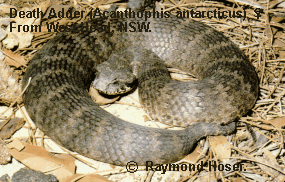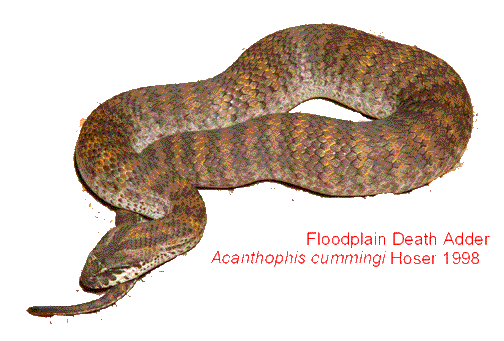ON MELANISTIC TENDENCIES IN DEATH ADDERS, ACANTHOPHIS ANTARCTICUS (SHAW).
By:Raymond T. Hoser, Then of: 170 Lawson Street, Redfern N.S.W. 2016, Australia.
1996 address: 41 Village Avenue, Doncaster, Victoria, 3108, Australia. Fax: +61 3 9857-4664.
This article was originally published in August 1985 in Litteratura Serpentium 4 (5), pp. 157-159. It had been written some years earlier. What follows is a text only (no italics) version.
 Introduction.
Introduction.
The author has held a number of death adders since late 1978. All 12 death adders involved in my Acanthophis antarcticus studies, are from the Sydney district and consist of 7 red phase and 5 grey phase snakes. Three of these snakes of the grey phase have had their colours become considerably darker, approaching a dark grey black in colour. It is interesting to note that no red phase death adders showed any melanistic tendencies. It is also interesting to note that not all grey death adders held by myself have melanistic tendencies. It should be noted that the three grey death adders with melanistic tendencies are the largest and most heavily built three, though definitely not the oldest three grey death adders held by myself. Various reasons have been postulated for the melanistic tendencies in the three death adders concerned. I have reservations about all reasons except for the fact that some feature of captivity does induce it.
1. Heating of snakes. Many death adders held by myself are heated and hence the correlation between heating and colour darkening appears obvious, however, one death adder (AAA-2) experienced maximum darkening whilst unheated for over 12 months. Thus this conclusion appears doubtful.
 2. Natural ageing processes. Among the specimens concerned, as they have aged they have tended towards melanacy. This melanistic tendency also has a correlation to the period of time in captivity. One death adder (AAA-11) showed marked melanistic tendencies whilst in the late juvenile stages and is now highly melanistic although only a young adult. No wild death adders from the Sydney district including large old adults observed by myself have shown nearly as strong a tendency for melanism as the three captive specimens mentioned. Dulling of colouration is definitely a feature of ageing in death adders, but tendencies towards melanism is not a feature of wild death adders.
2. Natural ageing processes. Among the specimens concerned, as they have aged they have tended towards melanacy. This melanistic tendency also has a correlation to the period of time in captivity. One death adder (AAA-11) showed marked melanistic tendencies whilst in the late juvenile stages and is now highly melanistic although only a young adult. No wild death adders from the Sydney district including large old adults observed by myself have shown nearly as strong a tendency for melanism as the three captive specimens mentioned. Dulling of colouration is definitely a feature of ageing in death adders, but tendencies towards melanism is not a feature of wild death adders.
3. Captivity stress. There is no evidence that death adders held by myself are under any form of stress. None have ever died in my possession and they thrive and breed. It has never been shown previously that a stressed snake will over an extended period of time grow darker in colour.
Table 1. Detailsof the three melanistic Death Adders.